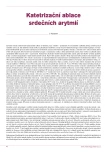-
Medical journals
- Career
Catheter ablation of atrioventricular nodal reentrant tachycardia: therapy of the first choise?
Authors: P. Pařízek; L. Haman
Authors‘ workplace: 1. interní klinika LF UK a FN Hradec Králové
Published in: Kardiol Rev Int Med 2006, 8(Supplementum): 13-18
Overview
Atrioventricular nodal reentrant tachycardia (AVNRT) is the most common form of paroxysmal supraventricular tachycardia. In this paper, a mechanism of arrhythmia, clinical features and electrocardiogram findings are reviewed. Disadvantages and risks of long-term pharmacologic therapy are discussed as the main reason for its replacement by definitive therapeutic strategy – catheter ablation. Catheter ablation should be offered as the first-line therapy for patients with AVNRT.
Keywords:
atrioventricular nodal reentrant tachycardia – therapy of atrioventricular nodal reentrant tachycardia - catheter ablation
Sources
1. Akhtar M, Jazayeri MR, Sra J et al. Atrioventricular nodal reentry: Clinical, electrophysiological, and therapeutic considerations. Circulation 1993; 88 : 282-295.
2. Sung RJ, Waxman HL, Saksena S et al. Sequence of retrograde atrial activation in patients with dual atrioventricular nodal pathways. Circulation 1981; 64 : 1059-1067.
3. Inoue S, Becker AE, Riccardi R et al. Interruption of the inferior extension of the compact atrioventricular node underlies successful radiofrequency ablation of atrioventricular nodal reentry tachycardia. J Intervent Card Electrophysiol 1999; 3 : 273-277.
4. Blomström-Lundqvist C, Scheinman MM, Aliot EM et al. ACC/AHA/ESC guidelines for the management of patients with supraventricular arrhythmias. Eur Heart 2003; 24 : 1857-1897.
5. Fiala M. Doporučené postupy pro diagnostiku a léčbu supraventrikulárních tachyarytmií. Cor Vasa 2005; 47 (9, Suppl): 18-39.
6. Alboni P, Tomasi C, Menozzi C et al. Efficacy and safety of out-of-hospital self-administered single-dose oral drug treatment in the management of infrequent, well-tolerated paroxysmal supraventricular tachycardia. J Am Coll Cardiol 2001; 37 : 548-553.
7. Mauritson DR, Winniford MD, Walker WS et al. Oral verapamil for paroxysmal supraventricular tachycardia: a long-term, double-blind randomized trial. Ann Intern Med 1982; 96 : 409-412.
8. Winniford MD, Fulton KL, Hillis LD. Long-term therapy of paroxysmal supraventricular tachycardia: a randomized, double-blind comparison of digoxin, propranolol and verapamil. Am J Cardiol 1984; 54 : 1138-9.
9. Anderson JL, Platt ML, Guarnieri T et al. Flecainide acetate for paroxysmal supraventricular tachyarrhythmias. Am J Cardiol 1994; 74 : 578-584.
10. Neuss H, Schlepper M. Long-term efficacy and safety of flecainide for supraventricular tachycardia. Am J Cardiol 1988; 62 (6D): 56-61.
11. Pritchett EL, McCarthy EA, Wilkinson WE. Propafenone treatment of symptomatic paroxysmal supraventricular arrhythmias: a randomized, placebo-controlled, crossover trial in patients tolerating oral therapy. An Intern Med 1991; 114 : 539-544.
12. Dorian P, Naccarelli GV, Coumel P et al. A randomized comparison of flecainide versus verapamil in paroxysmal supraventricular tachycardia. Am J Cardiol 1996; 77(3A): 89-95.
13. Wanless RS, Anderson K, Joy M et al. Multicenter comparative study of the efficacy and safety of sotalol in the prophylactic treatment of patients with paroxysmal supraventricular tachyarrhythmias. Am Heart J 1997; 133 : 441-6.
14. Gambhir DS, Bhargava M, Nair M et al. Comparison of electrophysiologic effects and efficacy of single-dose intravenous and long-term oral amiodarone therapy in patients with AV nodal reentrant tachycardia. Indian Heart J 1996; 48 : 133-7.
15. Chen SA, Chiang CE, Tai CT et al. Transient complete atrioventricular block during radiofrequency ablation of slow pathway for atrioventricular nodal reentrant tachycardia. Am J Cardiol 1996; 77 : 1367-1370.
16. Boulos M, Hoch D, Schecter S et al. Age dependence of complete heart block complicating radiofrequency ablation of the atrioventricular nodal slow pathway. Am J Cardiol 1998; 3 : 390-391.
17. Kalusche D, Ott P, Arentz T et al. AV nodal re-entry tachycardia in elderly patients: clinical presentation and results of radiofrequency catheter ablation therapy. Coron Artery Dis 1998; 6 : 359-363.
18. Yamane T, Iesaka Y, Goya M et al. Optimal target site for slow AV nodal pathway ablation: possibility of predetermined focal mapping approach using anatomic reference in the Koch´s triangle. J Cardiovasc Electrophysiol 1999; 10 : 529-537.
19. Calkins H, Yong P, Miller LM et al. Catheter ablation of accessory pathways, atrioventricular nodal re-entrant tachycardia, and the atrioventricular junction: final results of a prospective, multicenter clinical trial. Circulation 1999; 99 : 262-270.
20. Scheinman MM, Huang S. The 1998 NASPE prospective catheter ablation registry. Pacing Clin Electrophysiol 2000; 23 : 1020-1028.
21. Clague JR, Dagres N, Kottkamp H et al. Targeting the slow pathway for atrioventricular nodal reentrant tachycardia: initial results and long-term follow-up in 379 consecutive patients. Eur Heart J 2001; 1 : 82-88.
22. Schwacke H, Brandt A, Rameken M et al. Long-term outcome of AV node modulation in 387 consecutive patients with AV nodal reentrant tachycardia. Z Kardiol 2002; 5 : 389-395.
Labels
Paediatric cardiology Internal medicine Cardiac surgery Cardiology
Article was published inCardiology Review

2006 Issue Supplementum-
All articles in this issue
- Catheter ablations of cardiac arrhytmias in Czech republic: contemporary state
- AV node ablation: new aspects in the time of curative therapy of atrial fibrillation and cardiac resynchronization therapy
- Catheter ablation of atrioventricular nodal reentrant tachycardia: therapy of the first choise?
- Catheter ablation of accessory links: solved question?
- Catheter-based treatment of common atrial flutter yesterday and today
- Catheter ablation of atrial fibrillation: hope for all highly symptomatic patients.
- Catheter ablation of postincisional tachycardias: final solution or palliative treatment?
- Catheter ablation of ventricular tachycardia
- Catheter ablation of ventricular fibrillation: reality or fiction?
- Cardiology Review
- Journal archive
- Current issue
- Online only
- About the journal
Most read in this issue- Catheter ablation of atrioventricular nodal reentrant tachycardia: therapy of the first choise?
- Catheter-based treatment of common atrial flutter yesterday and today
- Catheter ablation of accessory links: solved question?
- AV node ablation: new aspects in the time of curative therapy of atrial fibrillation and cardiac resynchronization therapy
Login#ADS_BOTTOM_SCRIPTS#Forgotten passwordEnter the email address that you registered with. We will send you instructions on how to set a new password.
- Career

